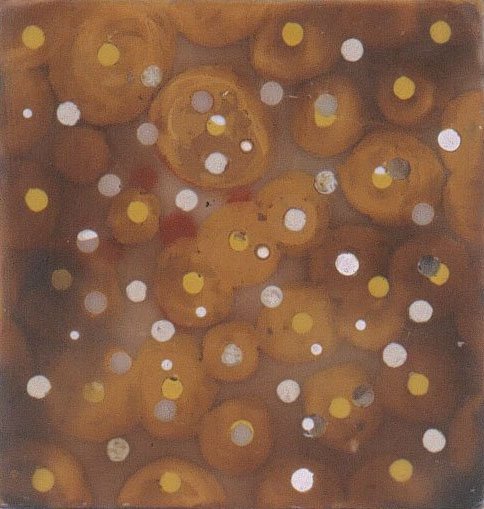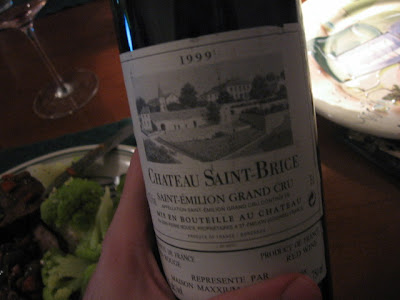




Is one in five accurate odds that the wine you open is spoiled? Our Dreaming of a White Christmas blind tasting -- hosted by Joe of Joe's Wine -- marked the second time he and I got together with five bottles. As it turned out, we found that one of the five bottles had gone off, just like what happened at our first event.
Back in October, I hosted a Cab Franc Table Talk night where I found that oxidation had all but ruined one particular bottle (to be fair, Joe was less categorical on this wine's demise). And then for Joe's white wine event earlier this month, we had a corker on our hands.
One in five bottles seems tremendously unlucky and much more than my usual day-to-day discovery of defective wine. But no complaints here, since Joe and I get so much out of these blind tasting nights. An evening of wine appreciation like these is so much more than the sum of its parts, even when there's a minus in the mix, so to speak.
So without further ado, here's our notes (Joe's are inset and mine follow) on some wines made from white grapes along the Spanish-French border: blends and varietals from Roussanne, Viognier, Grenache Blanc, Verdejo, Viura (Maccabeu), Malvoisie and the two Mansengs (Gros Manseng and Petit Manseng).
(The order corresponds with the bottles aligned across the top of the post, which are clickable images that offer more detailed product info.)
1. Domaine Mourgues du Grès Terre d'Argence Vin de Pays du Gard 2005
The decanter on the left held the Domaine Mourgues du Grès Terre d'Argence Vin de Pays du Gard, a blend of Roussanne, Viognier and Grenache Blanc. A new appellation for me, this wine was reminiscent of the white Hermitage I had recently. Yellow gold in the glass, the nose showed lavender, lemon, apple and toast. A touch thin on the palate, but as it warmed it showed a nice, rich apple flavour. Good acidity, but a bit hot. Very Rhone-like, and a nice effort.
Eyes: Darker than the others, kind of greyish
Nose: Apple, flowers, with complexity
Mouth: Honeycomb, note of cream supplanted onto a grassy edge. Full-bodied and heady.
Stomach: Had this one in a leftover minibottle so I opened it for dinner two days later. Vanilla notes totally pronounced where I hadn't thought to note anything earlier -- a sign or poor oak integration of poor conservation? In any case, with my dinner of trout and sautéed veg, it was an okay match but the woodiness was a bit overwhelming. For a fresh bottle, it'd be a great pairing for boldly seasoned Asian stir fries loaded with crunchy MSG'ed vegetables. An umami-suited wine.
François Collard, Beaucaire, France. 14.5%.
2. Château les Pins Côtes du Roussillon 2003The next decanter held a Château les Pins Côtes du Roussillon. Corked, unfortunately, as there were some neat aromas hiding underneath - cooked pears, flowers - and some almonds on the palate.
Eyes: Golden-yellow
Nose: Cardboard over white fruit
Mouth: Complexity is there but it's all coloured by cork taint. (Fruit from 2003 already receding it would seem making this even more pithy and pitty -- hard to assess whether buying another bottle would be in order.)
Stomach: This bottle would do a disservice to food.
Cave des Vignerons de Baixas, Baixas, France. 14.5%.
3. Palacios Remondo Plàcet Rioja 2005For both Marcus and I (and my wife who joined us later) the clear favourite was the Palacios Remondo Plàcet, a white Rioja wine made from the local Viura grape and reviewed here earlier this year. A pale white gold in the glass - the palest of the bunch - I thought it might be the Rueda by the colour. Very interesting on the nose – citrusy (limes), minerally, and floral – gorgeous. Elegant, rich and luscious, with a nice long bitter finish. Sometimes a great wine comes together so well that you can’t use words to describe why you like it so much – the Plàcet is one of those. Marcus and I just bought up the last bottles on the island (sorry).
Eyes: Straw
Nose: Flint, funky and direct -- this wine was less changeable, more distinctive than the others.
Mouth: Mineral but smooth, honeysuckle, with nutty-bitter finish. Medium body.
Stomach: Yum. My favourite style of wine of the bunch so I'd eat this with anything or drink it down all on its own. Joe's selection of cheeses from the Pyrenees did it justice, as did a salmon mousse and yeasty baguette. Even a saucisson side -- why not? Entirely lovely.
Alfaro, España. 13.5%.
4. Domaine Cauhapé Sève D'Automne Jurançon 2004The next decanter held the Domaine Cauhapé Sève D'Automne, a wine from the Jurançon sec appellation (made from the Gros Manseng grape) and tasted in my Southwest France review. Deep yellow gold in the glass, it showed green melon, banana, honey and pineapple on the nose. The tropical theme continued on the palate - papaya and melon, with a nice bitter and minerally finish. Once again, the whopping alcohol was not overly apparent. Flavourful and elegant, but an extrovert amongst a more reserved peer group. Note: the priciest wine of the evening.
Eyes: Golden, most visually consistent of the bunch, viscous
Nose: Exotic fruit, honey
Mouth: Linear attack, white plum, spice changing more to green apple with a long finish. Nice acidity. Lime zinginess.
Stomach: What a well-made wine -- the way the acidity holds up against the fatness of the fruit. Had leftovers with dessert the following night and though this is a sec, is great with any course. Delicious!
Monein, France. 15%.
5. Bodegas Aura Rueda 2005The decanter on the right held a Bodegas Aura, a Verdejo from the Spanish Rueda appellation. This golden wine was rather simple - apples and lemon rind on the nose, some minerals. On the palate is was thin and light, lemony and minerally, with a nice crisp aftertaste. Kinda Pinot Griggio-ish, this was a terrific white quaffer - uncomplex, but fun. And the best price of the evening...
Eyes: Yellowish
Nose: Crisp nose of gooseberries and white pepper
Mouth: A full-fronted attack: Racy, appley, lots of zest. A bit of alcohol on the finish lingers. Odd resinated quality.
Stomach: A stand-in for Sauvignon in term of food pairings. There was a goat cheese (Tomme de Chevre des Pyrenees) that Joe served that initially suggested a good fit, but I think it liked it best with an interesting and zesty semi-hard cheese from Spain called Manchego. Clearly, Joe's cheese-mongering abilities live up to his keen wine appreciation.
Castilla y León, Rueda, España. 13.5%.
 From left to right (click to enlarge):
From left to right (click to enlarge):













































